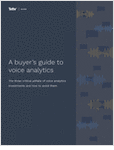 | Companies have historically recorded their customer conversations for quality assurance, training and compliance purposes but, until recently, have had no way of mining this data for insights—at least not in a scalable and cost-effective way. Instead, companies have relied on people (typically in quality assurance) to manually listen to calls to glean information. Because of the labor-intensive nature of the work, companies have typically listened to less than one percent of their recorded customer conversations—leaving the remainder to collect dust in faraway data centers. So, it comes as no surprise that there’s been such an explosion of interest in new voice analytics technologies—powered by automatic speech recognition, natural language processing and artificial intelligence—to finally shed light on this dark data asset. Unfortunately, the excitement around these new technologies is far outpacing the success that companies have actually achieved. Our research has found that more than 80% of speech analytics investments fail to deliver their intended ROI. In this guide, learn about the three critical pitfalls most companies encounter when investing in voice analytics and how to avoid them. Request Free! |
